
Text © DrSc Giuliano Russini – Biologist Zoologist

English translation by Mario Beltramini
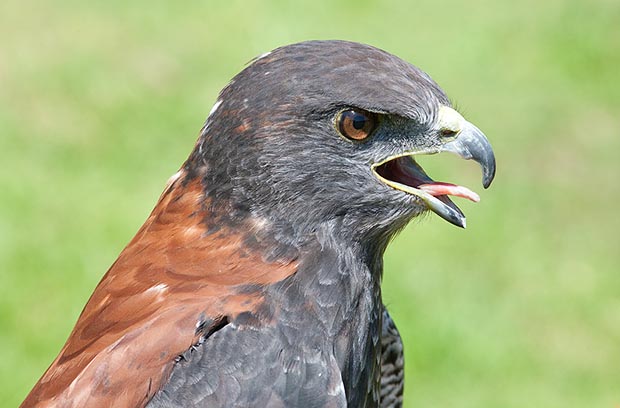
Aggressive Buteo albicaudatus with typical sickle-like beak to tear the preys © Giuseppe Mazza
All diurnal birds of prey, the so-called raptors, have been grouped in three different orders that differentiate their diverse morphological characteristics and the different genetic location.
The Catarthiformes, that include the New World vultures, the Falconiformes, with the falconets and the hawks and the Accipitriformes that include eagles, Old World vultures, buzzards, sparrow hawks, harriers and the monospecific secretary bird and osprey.
This last order is the vastest and includes as many as 248 of the 316 species until today classified that represent the whole diurnal raptors.
The general characteristics of the membres of all the families afferent to the order of the Accipitriformes are traceable to morphological adaptation lines and of general tendency.
These birds are characterized by the presence of a robust and hooked beak, with sharp edges, suitable for tearing the flesh and provided at the base of a particular cere, where open the nostrils. Flat head with sloping forehead, sternum with two incisures or holes, wings fairly strong and powerful flight. The tail is usually formed by twelve tail feathers.
The legs are robust, often having feathered tarsi and a structure called “trousers”. The foot has four very mobile toes and the fourth may be may be opposable. The claws, with which the toes end, are robust, very long and remarkably curved, in order to seize the preys. The plumage is usually thick and hard.

The long and sharp beak of Gyps fulvus is the best for dissecting big corpses © Giuseppe Mazza
There are remarkable differences of dimensions between the two sexes: the female is almost always bigger than the male.
They have a wing beats or gliding flight. Finally, the feeding, mostly carnivorous, is formed by invertebrates and vertebrates, either alive or dead (carrions).
Except for the vultures, the other accipitriforms nourish mainly of preys seized alive. The not digested remnants of their meales (bones and cornea structures) are ejected in the forms of “wads”, which, due to the powerful stomach acids, give however an imperfect idea of what has been eaten.
They nest on the tops of the trees as well as on the tops of the rocks, and, in some instances, even on the ground.
The hatching begins from the deposition of the first egg, and this causes, in the polyovulatory species, a difference in age between the young.
The pullets come out covered by down, but it is always an altricial-inept, that is nidicolous, offspring and their breeding, done by both parents, lasts at times long time, with peaks of 130 days. Most species of this order are solitary or do live in stable pairs. But some of them are social and even nidify in colonies.
All diurnal birds of prey are far-sighted. This depends on the density of the cone cells on the retina which grants them a very sharp diurnal vision (called photopic), which is about ten of times bigger than in the man, contrary to the Strigiformes, the nocturnal birds of prey, which have a bigger retina density for the rod cells, as adaptation to the diurnal vision.
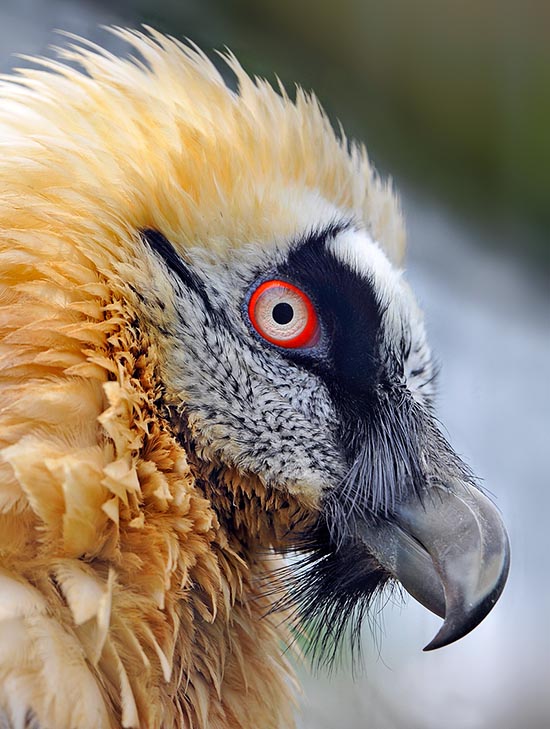
Gypaetus barbatus, with 280 cm of wingspan, eats only bones and their protein mallow © Gianfranco Colombo
Possibly the species of diurnal birds of prey belonging to the order of the better endowed in the eyesight Accipitriformes, are the eagles but all the diurnal raptors afferent this order have an exceptional eyesight. It is difficult to make a classification. By sure, in ecological terms, this adaptation is the cause of their mode of nutrition. But, talking evolutionarily, we have to wonder if it has been the type of environment where they have adapted to live, to generate, selecting them, the individuals with an increasingly sharp eyesight, this has allowed them to colonize and live on the tops of the mountains and of the trees, or in open barren areas, where animals like wild rabbits, hares, grouse pecking on the ground, or serpents and saurians, for instance, may quite well camouflage and, consequently, only animals having such a sharp vision (rightly, like for the birds, the diurnal raptors, and for the mammals, lynxes, wolves, foxes, hyenas, cheetahs, etc.) may survive. The order of the Accipitriformes is subdivided in three families:
► The family of the (Accipitridae, Vieillot 1816), counting even 7 genera with 248 species and more than 500 subspecies diffused on almost all emerged lands, excepting the Sahara and the Antarctica.
Among the various genera we cite: Elanus, Pithecophaga, Aegypius, Gyps, Pseudogyps, Gypaëtus, Circus, Gymnogenys, Ichthyophaga, Buteo, Milvus, Accipiter, Heliaëtus, Harpia, Aquila, etc.
Among the various species, we remind the Red kite (Milvus milvus), the Black-winged kite (Elanus caeruleus) , the Eurasian, or Northern, sparrow hawk (Accipiter nisus) , the Common buzzard (Buteo buteo) , the Harpy eagle (Harpia harpyja) , the Golden eagle (Aquila chrysaëtos), the Sea eagle (Heliaëtus albicilla), the White-head Sea eagle or Bold eagle (Heliaëtus leucocephalus), symbol of the United States of America, etc.
► The family of the Pandionids (Pandionidae Linnaeus, 1758), has one genus only, the Pandion, to which belongs only one species, the Fish hawk (Pandion haliëatus).
► The family of the Sagitarids (Sagittaridae J.F. Miller, 1779), with the only one genus Sagittarius to which belongs only one species, the Secretary bird (Sagittarius serpentarius), of the African savannahs.
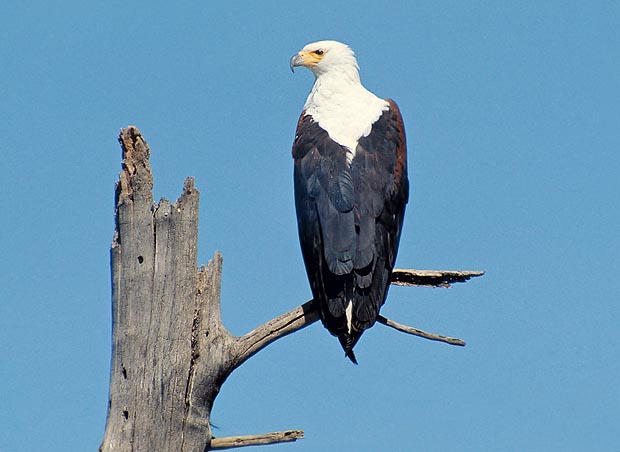
Excellent eyesight. Nothing escapes to this Fish eagle (Haliaeetus vocifer) © Giuseppe Mazza
The membres of the family of the Accipitridae have very variable dimensions. The Lammergeier (Gypaetus barbatus) is 1,10-1,20 m long with a weight of about 6 kg, whilst a small kite of the genus Gampsonyx is only 19 cm long, with 500-600 g of weight, but resemble each other from the anatomical point of view: the nostrils are separate (that means, independent), the digestive tract has caecal appendages, and the first toe is considerably developped. These particularities distinguish the accipitrids from the cathartids (order Cathartiformes).
Other characteristics, such as the shape of the beak, of the nostrils, the number of the cervical vertebrae, 14 to 17, conversely, separate them from the falconids. The eagles are the biggest and strongest species of this family. Their wingspan, averagely, may exceed the metre and twenty, and their weight varies from 1 to 7 kg.
Other genera of accipitrids, like Aquila and Hieraaetus, have a very vast distribution, whilst others are found only in some continental zones, such, for instance, the Harpy eagle (Harpia harpyja), of central and southern America, and the Monkey-eating eagle or Philippine eagle (Pithecophaga jefferyi), nowadays at home only in the archipelago of Philippines.
Some species live in the forests, like the Booted eagle (Hieraaetus pennatus), others the barren savannahs, such as the Steppe eagle (Aquila nipalensis), but all do hunt preys of remarkable size. The biggest ones are seized by the Golden eagle (Aquila chrysaetos), that attacks, for instance, the young lambs in Scotland, and by the Harpy eagle (Harpia harpyja), that nourishes of monkeys and sloths in the Venezuelan forests.
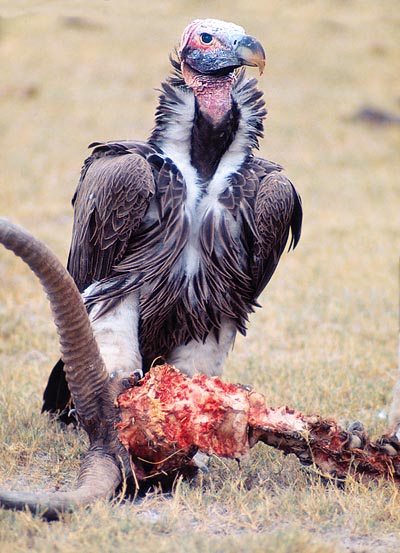
Nubian vulture (Torgos tracheliotus) eating © Giuseppe Mazza
The unjustified and prolonged persecution of these wonderful birds done by the man, in the so-called “civilized” countries, has obliged them to take shelter in the less accessible regions, such as the mountains.
The eagles build up a nest of dry branches on a tree or on a rocky ledge. Their reproductive rate is unfortunately very modest: 1-3 brown speckled eggs, on whitish background, are hatched 40 to 50 days and often the born eaglets do not come to “fruition”, because the more robust brothers eliminate the frailest ones.
The biggest eagles fly heavily, but are all able to glide with great skill. In Italy we still find the Golden eagle (Aquila chrysaetos) and in Sardinia and perhaps also in Sicily, the Bonelli’s eagle (Hieraaetus fasciatus).
The buzzards are close to the eagles and resemble them even in the silhouette, but differ from them for the relative weakness of the legs and because, despite the anything but negligible dimensions, are content with small preys (rodents and other gnawers, reptilians, land birds), they catch mainly at the appearance and taking them by surprise. The main genera are Buteo, Butastur (Africa and Asia), Parabuteo, Buteogallus (America). The Common buzzard (Buteo buteo) is one of the most common raptors in Italy.
Most of the Goshawks and Sparrow hawks (genera Accipiter and Urotriorchis) have a cross-striped plumage in the lower part of the body, short and rounded wings and fairly long tail. Among all accipitrids athey are the fastest in flight. As a matter of fact, they base their hunting technique in the pursuit of the birds at high speed, which, however, are able to maintain only on short distances. Despite their relatively modest size, thanks to their particular temper, they are able to catch even preys of their same size.
The smallest accitripids are found in the group of the Little sparrowhawk (Accipiter minullus), African, present in the red list of the IUCN, that measures just 21 cm.
The three songbirds species, of the genus Melierax, the so-called chanting goshawks: the Dark chanting goshawk (Melierax metabates), the Pale chanting goshawk (Melierax canorus) and the Eastern chanting goshawk (Melierax poliopterus), lead an aberrant kind of life. In fact, they hunt running in the savannah utilizing their tarsi, which are rather long. Goshawk and sparrow-hawk nidify in many sites of Italy. The Harriers, genus Circaetus and the Snake eagles, genera Dryotriorchis, Spilornis and Terathopius, are big diurnal raptors with a length varying from 46 to 62 cm, specialized in catching the reptilians.
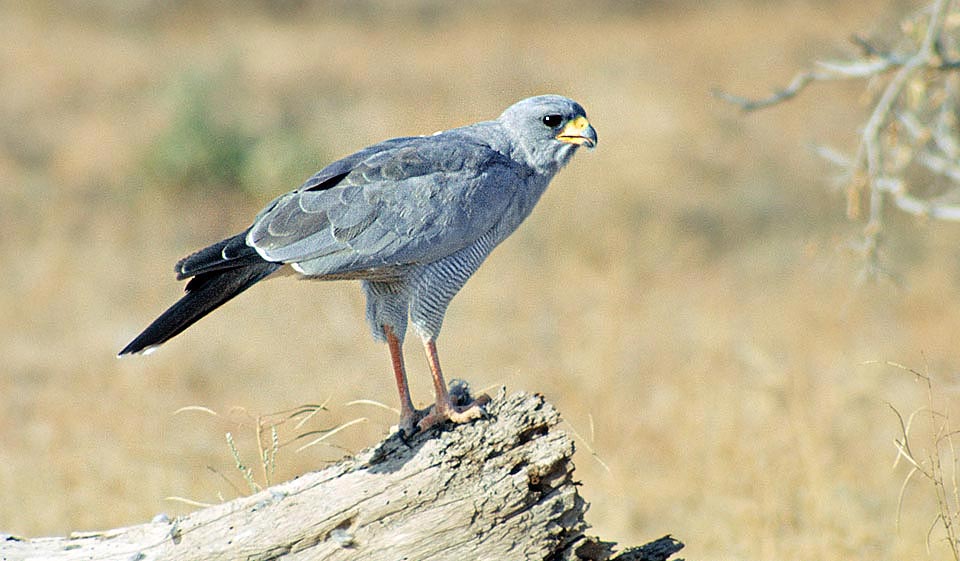
Atypical accipitrid, Eastern chanting goshawk (Melierax poliopterus) exploits the long tarsi to hunt afoot, running in the savannah © Giuseppe Mazza
They look for their victims overflying for a long time the hunting grounds or waiting for them when passing by. These birds lay only one egg and the These birds lay one egg only and the incubation is much long. The Short-toed snak eagle (Circaetus gallicus) still nidifies, even if not frequently, in Italy migrates to Africa.
The Harriers of the genus Circus divide in 10 species, and two other genera have an averagle length of 45 cm. These birds are easily recognized due to their elongated appearance and their flying low with slow wing beats which alternate with glides or with slips. Furthermore, unlike the raptors described so far and the others of which we shall treat later, they nest electively on the ground, in the prairies, in the fields, in the swamps and in the steppes, which form their typical environment.
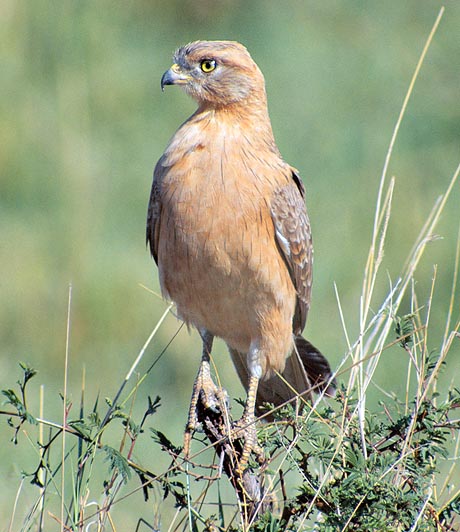
The Grasshopper Buzzard (Butastur rufipennis) eats mainly insects © G. Mazza
Usually, the plumage is pale (mixed grey, dirty white), but at times dark, as it happens in the case of the Western marsh-harrier (Circus aeruginosus). The sexual dimorphism is quite evident, especially due to the colouration. More than a few species of the temperate regions are migratory.
They nourish of small preys (insects, rodents, sciurids, small birds, lizards, small serpents), which they seize on the ground. The western marsh-harrier and the Montagu’s harrier (Circus pygargus) still nest in Italy.
The Kites (8 species leading to the genera Milvus, Haliastur, Ictinia, Harpagus, etc.) are birds of reasonable size, for instance 60 cm of length for the Red kite (Milvus milvus), but little gifted for active hunting. The ornithological biologists have often remarked that they content of injured animals, such as fishes, rodents, birds or of carrions, and that at least one species is parasitic of other more powerful raptors, being specialized in the stealing of preys, carried by the last ones to the nests for nourishing their progeny. The species of the American genus Ictinia are mostly insectivorous.
The kites love the proximity of the waterways and of the lakes, where they find a part of their feeding. Some species have a biforked tail. The Black kite (Milvus migrans) and the Red kite still nidify in Itay.
The sea eagles resemble to the true and proper eagles due to their huge size, weight 4-6 kg and length up to 90 cm in the Common sea eagle (Haliaeetus albicilla). There are two genera: Haliaeetus (8 species among which the Haliaeetus vocifer) and Ichthyophaga (2 species). They all live by the sea, or on the lakes, or along the banks of the rivers and of the large freshwater courses, where they seize the fishes and collect dead or dying animals. The youngs of the sea eagles are found at times even in the Mediterranean.
The Honey buzzards belonging to the genus Pernis, are insectivorous raptors in spite of their remarkable size. The Western or Common honey buzzard (Pernis apivorus) may reach, for instance, the 50 cm. This group includes also the genus Henicopernis and others, but those of the genus Pernis are the most specialized, with adaptations to alimentary regimes based on stinging insects, especially Hymenopters (Hymenoptera).
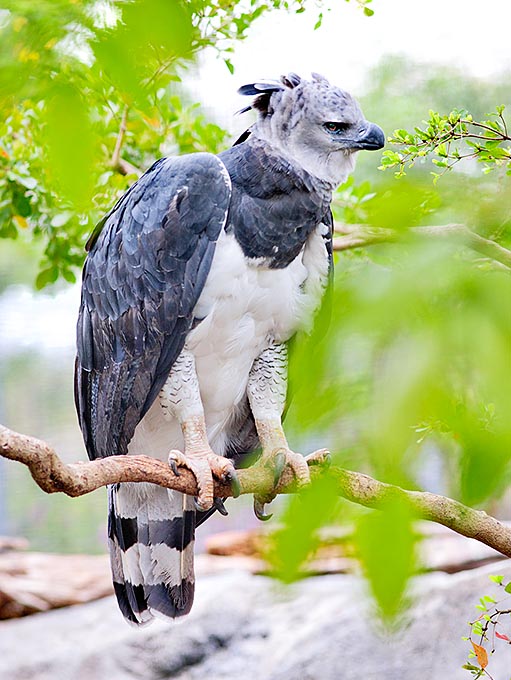
The scaring Harpia harpyja predates monkeys and sloths in the Venezuelan forests © Giuseppe Mazza
So, the raptors of the genus Pernis have the nostrils slit-shaped, edge of the beak and of the eyes covered by small scaly feathers, very thick, and little curved nails suitable for digging the soil to uncover the nests of the Bumble bees (Bombus) and of the wasps. The only migratory honey buzzards are those autochthonous to the temperate regions. The Common, or Western, honey buzzard (Pernis apivorus) nidifies in Italy.
To the group of the honey buzzards connect some raptors with similar diet: genera Chondrohierax and Leptodon in the New World and Avicea in the Old one.
The white kites are small birds (of America and of the Old World) which distinguish for their definitely clear colouration (grey and white, with black zones) and their insectivorous diet.
The Swallow-tailed kite (Elanoides forficatus), American, resembles much to them. The Bat hawk, belonging to the genus Machaerhamphus, subfamily of the Machaerhamphinae, of Africa and eastern Asia, deserves a particular citation due to its monophagous or stenophagous diet: this species seizes almost exclusively the bats that in the evening take off getting out from the dens where they have spent the day.
Thus, this raptor, if compared to the previous ones, has crepuscular habits and keeps idling during the day.
Finally, two unusual birds of the genus Rostrhamus, with thin and much curved beak, mostly, if not exclusively, nourish of gastropod molluscs and live in America.
The Old World vultures (16 species) have been, for long time, placed in a standing alone family by the ornithological biologists, that of the Egipids (Egiipidi), justifying such classification with their biology.
They are big birds. The smallest one, the Egyptian vulture (Neophron percnopterus), measures a wingspan of 1,60 m. The greatest one is the Lammergeier (Gypaetus barbatus), with the black, brown and beige, at times mostly white, plumage, with very long and broad wings which allow them to glide extremely well.
All, but the lammergeier, have the head and the neck without feathers, covered only by a more or less scattered down. The legs have feet with weak fingers and suitable for walking.
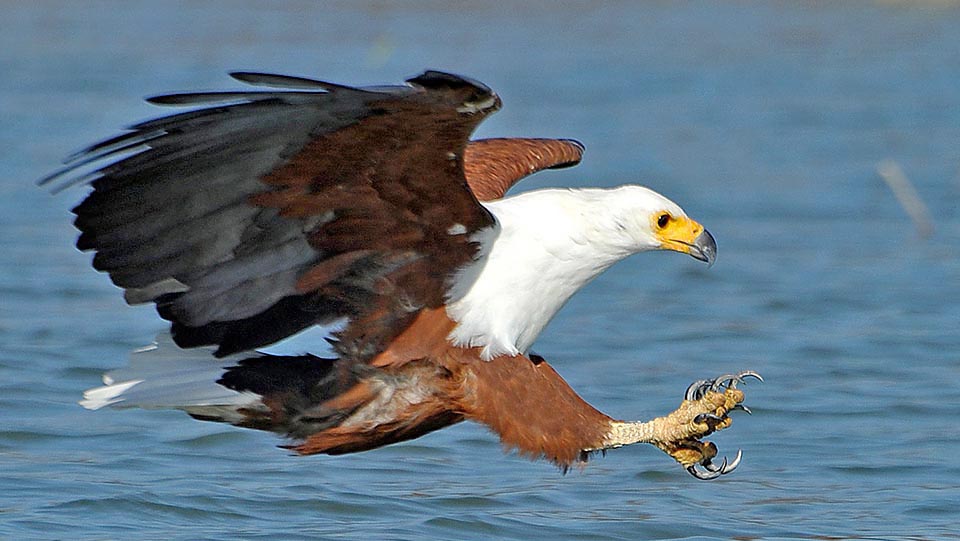
Common in almost all sub-Sahara Africa, close to streams or pools of water, the Haliaeetus vocifer conversely prefers fishes © Gianfranco Colombo
The vultures live in the poor, desert and mountainous regions. They are “necrophagous” and the presence of herds of ungulates is one of the conditions of their existence, as they nourish almost exclusively of the corpses they may sight.
The Palm-nut vulture (Gypohierax angolensis), African, eats also fruits. The lammergeyer, on the contrary, nourishes almost exclusively of bones. Only one white with brown dots egg is laid and the incubation lasts from 46 to 53 days, depending on the species. The Griffon vulture (Gyps fulvus), race (Gyps fulvus fulvus), is still found in Sardinia, whilst it has recently disappeared from Sicily.
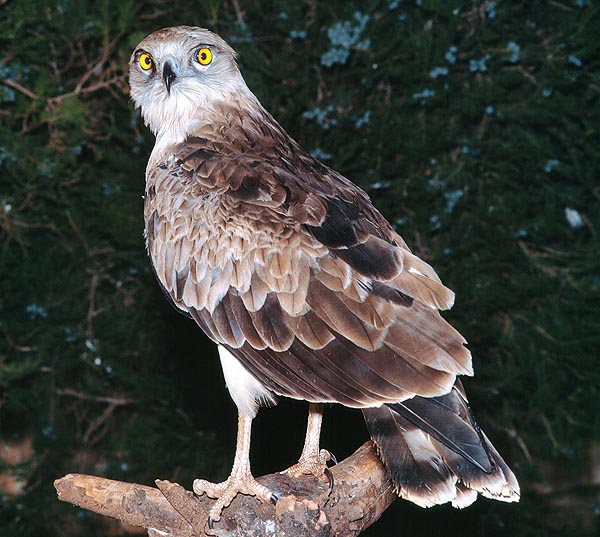
Circaetus gallicus hunts almost exclusively snakes, averagely 3 by day © Giuseppe Mazza
The Egyptian vulture should still live in the central-southern Appennines, and finally the lammergeier might still be present in Sardinia.
The family of the Pandionids (Pandionidae) concerns the the only species Fish hawk (Pandion haliaëtus). This bird is, as aforementioned, still nowadays placed by many ornithological biologists into the family of the Accipitridae, but its morphology and its biology, absolutely special, has prompted the taxonomical biologists to allocate him a proper one. Actually, it is the only diurnal raptor nourishing exclusively of fishes which it catches by diving into the water. The legs with bare tarsi end with toes whose surface is covered by corneous spiculae, particularly suitable for holding scaly and slimy preys. Furthermore, we have also to note that the outer toe is reversible, that is, it may be led further back than the outer finger of many other species and this further facilitates the grip.
The fish hawk is practically found all over the world, excluding southern America. It does not nidify any more in Italy. Perhaps some couples does its nest in Corsica, whilst in the peninsula, during the pass, some individuals can be observed while stopping mainly along th main rivers. Unluckily, they are often killed by the hunters.
The family of the Sagitarids (Sagitariidae) is that of the Secretary bird (Sagittarius serpentarius), of the African savannahs. Due to its hooked beak, the diet based on small vertebrates (reptilians, batrachians, and small rodents) and its mode of reproduction, this bird is definitely a raptor. If, however, we consider its long legs (whose toes are fused at their base by means of an interdigital membrane, “syndactylous foot”) and the habits and the style of life, mostly terrestrial, we might be led to think that its similarities with birds such as the bustards and the cranes are remarkable. Among the other odd characters, the secretary bird, which measures 1,15 m of length and 2,10 m of wingspan, there is that of having median rectrices much elongated, that exceed the other feathers of 13-15 cm and an occipital crest which earned it the English name of secretary (Secretary bird), referring to the habit the secretaries had, once, of settling down the pen on the ear. It has a grey-black plumage.
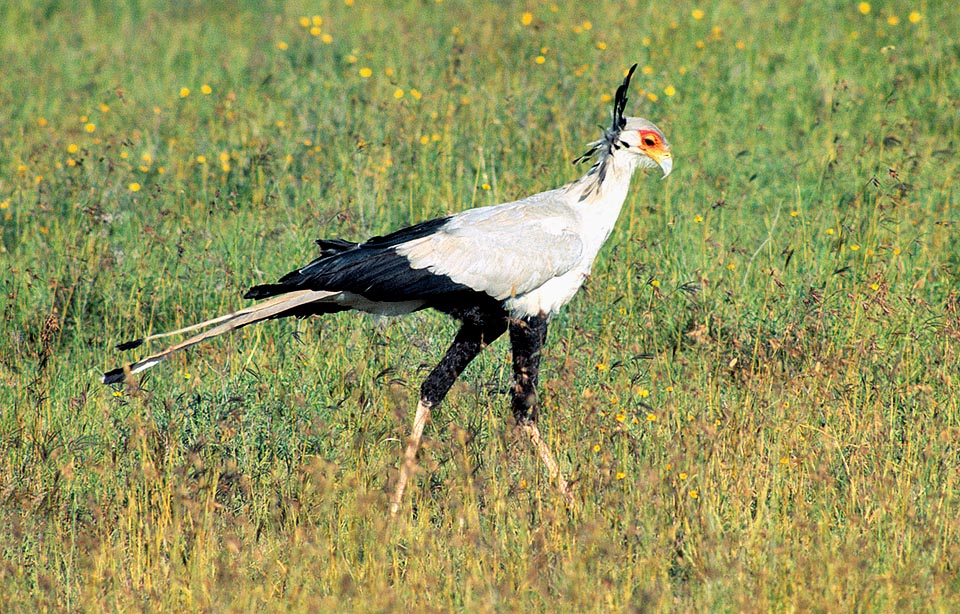
Apart some insect, nidiaceous or small mammals, also for the odd Secretary bird (Sagittarius serpentarius) the main dish is formed by the snakes. Usually the prey is stunned with a strong kick of the armored legs, held with the clawed toes and seized with the strong beak to be then swallowed whole © Giuseppe Mazza
